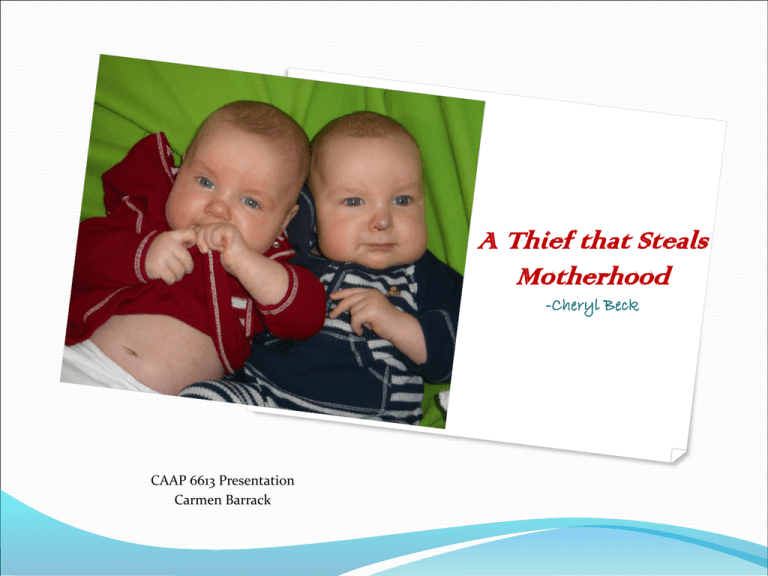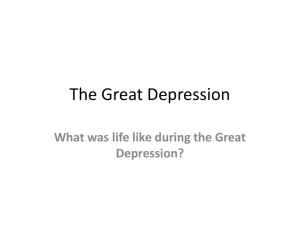Postpartum depression: The Thief that Steals
advertisement

A Thief that Steals Motherhood -Cheryl Beck CAAP 6613 Presentation Carmen Barrack POSTPARTUM DEPRESSION According to Statistics Canada (2005) there were: •447, 485 pregnant women in Canada •54, 646 pregnant women in Alberta Boyd, Le and Somberg (2005) state researchers use the rate of 13% to calculate the number of women who suffer with postpartum depression. This equates to: •58,173 women in Canada •7,103 women in Alberta 50% of those who experience postpartum depression will go undiagnosed and needlessly suffer alone (“Healthy People”, 2010) •Close to 30,000 women in Canada •Over 3,500 women in Alberta 1. Lois Hole Hospital for Women Case Study -Move Toward Early Universal Screening 2. What is Postpartum Depression? -Baby Blues or Postpartum Depression? -Risk Factors -Short and Long Term Consequences 3. Current Assessment Issues in Screening for PPD - DSM-IV-TR Diagnosis Complications -Lack of Rigorous Guidelines – who, what, where, when??? 4. Suggested Assessment Framework for PPD Screening -Reduce the Stigma through Education -Multi-modal Understanding of PPD -Formal Assessment Options -Integrative Approach -Conclusion: Working Together for a New Mother’s Well-Being 5. Questions and Discussion POSTPARTUM DEPRESSION Alone and Adrift... http://www.youtube.com/watch?v=Sp7eyIR0Dw4&feature=related What is Postpartum Depression? The Baby Blues are: A Normal Biological Response Early Onset, usually days after giving birth Lasts approximately 2 weeks Feeling overwhelmed, tired and sad due to the demands of their new role of being a mother PPD is: A Mood Disorder Onset can be first year postpartum Lasts longer than 2 weeks Feelings are more extreme Depression during pregnancy & postpartum. (2010). Postpartum Support International. Retrieved from: http://postpartum.net.gravitatehosting.com/Get-the-Facts/Depression-During-Pregnancy-Postpartum.aspx -Change in Appetite -Anger, frustration, irritability -Can’t concentrate -Excessive crying -Feeling like they can’t cope -Loss of interest in activities -Loss of energy -Negative thoughts about baby or over concern -Feeling like they could harm baby or oneself http://www.youtube.com/watch?v=odRwFfWLml8&feature=related Depression during pregnancy & postpartum. (2010). Postpartum Support International. Retrieved from: http://postpartum.net.gravitatehosting.com/Get-the-Facts/Depression-During-Pregnancy-Postpartum.aspx 1) Past history of depression, PPD (if she has children), and/or anxiety -Has she been under a doctors care for same, i.e. Medication 2) Presence of an identifiable support system. Single mothers are twice as likely to develop PPD. 3) Was the birth "traumatic" versus very difficult (as is often viewed by new moms) 4) Were there any previous pregnancy losses D. Boddington (personal communication, July 4, 2011) 1) Socioeconomic Status – women in poverty are exposed to additional social and physical stressors increasing the likelihood, intensity and length of PPD (Evans & Kim, 2007; Petterson & Albers, 2001) 2) Maternal age and education (Lung, Shu, Chiang and Lin, 2009) 3) Breastfeeding (Mancini, Carlson & Albers, 2007) 4) Life Stresses – financial, marital, losses 5) Pre-existing Medical Conditions – thyroid, diabetes 6) Infertility Issues or Multiples (“Depression during pregnancy”, 2010) 7) Sick or Difficult Baby (McCrae et al., 2000) Potential Consequences of PPD Short-Term Long-Term Insecure attachment and Developmental Impairments: altered brain development in baby (Dawson et al., 1999; Misri & Emotional, Cognitive and Behavioural (Evans & Kim, 2007; Hay, Kendrick, 2008) Pawlby, Perra & Sharp, 2010; Petterson & Albers, 2001) Mother’s quality of life and well-being are diminished Strain on support network (Barnes, 2006) Turning our Attention to Current Assessment Issues 1. Postpartum Depression is classified as 296.90 – Mood Disorder Not Otherwise Specified 2. There is a postpartum onset specifier with some common symptoms listed, but... 3. Must be within 4 weeks of delivery 4. DSM-V may increase onset to 6 months (Stone, 2010) No Differential Diagnosis for Postpartum Depression in DSM-IV-TR (2000). Does this affect assessment procedures? Diagnosis? Will the time change help? Is a differential diagnosis needed? Image Retrieved from: http://www.bing.com/images/search?q=DSM-IV-TR+(2000)+picture&view=detail&id=B3AA85599D9C9E944ECF664C3F0FFCA93888474E&first=0&qpvt=DSM-IVTR+(2000)+picture&FORM=IDFRIR Turning our Attention to Current Assessment Issues 1. Who is Assessing for PPD? 2. When are the Assessments being done? 3. Where are the Assessments taking place? 4. What Assessment procedures and screening tools are being used? Lack of Standardized Guidelines in Alberta and Canada What role should counsellors/psychologists play in the screening process? POSTPARTUM DEPRESSION Reduce the Stigma through Education 1. Educate new mothers about the importance of their mental health. Conversational. Normalizing. (Beck 2006;Vik, Aass, Britt & Hafting, 2009) 2. Informal multimodal assessment to determine risk and take preventive action. In private (Cox, Holden & Sagovsky, 1987) Educate mother and supporters about PPD: prevalence, symptoms, onset, community resources 4. Provide written information and contact details 3. Procedural Suggestions for Lois Hole Hospital Counselling Department: Approach & Thoroughness Pacific post partum support society. (2010). Retrieved from: http://www.postpartum.org/Wheel%202009.pdf When? Where? For mothers informally determined to be at risk, follow-up screening appointments should be made with the hospital counselling center within 2-4 weeks of a baby’s birth at which time a formal assessment is conducted. Assess Early!!! By Who? To screen as many mothers as possible, formal assessment tools could be administered during routine postpartum visits (doctor, nurse?) or at baby vaccination visits. Assess Every Mother!!! Which option is better? Consider training, time and referral system to increase compliance & outcomes (Gjerdingen & Yawn, 2007; Mansini, Carlson & Albers, 2007;Vik, Aass, Britt & Hafting, 2009) What Formal Screening Tools Are Available? Most Suitable? 1. Most Validated Screening Tool -53 studies, during pregnancy, for fathers (Hewitt, Gilbody, Mann and Brealey, 2010) 2. Available in 20 Languages (Hewitt et al., 2010) 3. Free, Downloadable 4. Short Screening Tool (Mitchell & Coyne, 2007) 5. Easy to Administer, Score (Cox et al., 1987) 6. Readability (Dennis, 2004) 1. Cut-Off Scores (Chaudron et al., 2010) 2. No Irritability Measure (Beck & Gable, 2000) 3. Greatest range in sensitivity, specificity and positive predictive value (Boyd et al., 2005) Postpartum Depression Screening Scale 1. Overall sensitivity, 1. Must be specificity & PPV greatest (Boyd et al., 2005) 2. New: only test to include cardinal symptoms of irritability, anxiety, insomnia, agitation, confusion (Beck & Gable, 2001) 3. Easy to Administer, Score (Beck & Gable, 2000) 4. Readability (Beck & Gable, Purchased 2. Available in 2 Languages (Hewitt 2000) (Beck & Gable, 2000) Published by: Western Psychological Services Retrieved from: http://portal.wpspublish.com/ et al., 2010) 3. 35 Questions 4. Not greatly studied (Hewitt et al., 2010) Beck Depression Inventory -II 1. Top 10 Psychological Test in Terms of Use (Santor et al., as cited in Anthony & Barlow, 2010) 2. Lends to a clinical diagnosis 3. Strongest Specificity (Boyd et al., 2005) 4. Easy to Administer, Score (Beck et al., 1996) 5. Readability (Beck et al., 1996) 6. Can be used with clients as young as 13 yrs (Beck et al., 1996) 1. Not specific to PPD 2. Must be Purchased 3. Available in 2 Languages (Hewitt et al., 2010) Comparing Psychometrics To select a formal screening tool for a universal program, one should consider accuracy, clinical-effectiveness, cost and acceptability (Hewitt et al., 2010). All three tools can successfully (AUC > 0.8) detect women with postpartum depression; no significant difference in test accuracy (Chaudron et al., 2010). What is your vote? Boyd, R. C., Le, H. N., & Somberg, R. (2005). Review of screening instruments for postpartum depression. Archives of Women’s Mental Health, 8, 141-153. doi: 10.1007/s00737-005-0096-6 Combining Professional Judgement & a Formal Testing Tool to Screen for PPD http://www.mededppd.org/care_pathways.asp?source=banner Care pathways. (2009). MediSpin Inc. Retrieved from: www.mededppd.org Sample Framework Conclusion 1. 2. 3. 4. 5. 6. 7. Mental health professional perform universal informal assessment (questions) with every new mom in the hospital. Formal assessment screening tool(s) administered early by counselling professionals for those deemed at-risk. If clinical diagnosis needed, BDI-II. If not, PDSS. Formal assessment screening tool administered by a nurse at either public health clinic or doctor’s office for general population. EPDS suggested. Referral system in place to send mothers with possible PDD later onset or previously missed. Screening is not diagnosis. SCID is required for a final diagnosis. Nonjudgmental, multimodal assessments that initiate dialogue and build/strengthen rapport necessary throughout the process! INFORMED CONSENT! http://www.youtube.com/watch?v=NaVBwp0xHEo Questions to Discuss DSM-IV-TR (2000) Issue: Does this affect assessment procedures? Diagnosis? Will the time change help? Is a differential diagnosis needed? Lack of Guidelines Issue: What role should counsellors/psychologists play in the screening process? Thoughts about Initial Informal In-Hospital Assessment Procedure: Procedural Suggestions for Lois Hole Hospital Counselling Department: Approach & Thoroughness Doctors Office or Public Health Clinic: Which option is better? Consider training, time and referral system to increase compliance & outcomes Screening Tool Options: What is your vote? References Antony, M. M., & Barlow, D. H. (2010). Handbook of assessment and treatment planning for psychological disorders (2nd ed.). New York: Guilford Press. Barnes, D. L. (2006). Postpartum depression: Its impact on couples and marital satisfaction. Journal of Systemic Therapies, 25, 25-42. Retrieved from http://www.guilford.com/cgi-bin/cartscript.cgi?page=pr/jnst.htm&dir=periodicals/per_psych Beck, A. T., Steer, R. A., & Brown, G. K. (1996). Beck Depression Inventory manual (2nd ed.). San Antonio, TX: Psychological Corporation. Beck, C. T. (2006). Postpartum depression: It isn’t just the blues. American Journal of Nursing, 106, 40-50. Retrieved from http://www.nursingcenter.com Beck, C. T., & Gable, R. (2000). Postpartum depression screening scale: Development and psychometric testing. Nursing Research, 49, 272282. Retrieved from http://journals.lww.com/nursingresearchonline/pages/default.aspx Beck, C. T., & Gable, R. (2001). Comparative analysis of the performance of postpartum depression screening scale with two other depression instruments. Nursing Research, 50, 242-249. Retrieved from http://journals.lww.com/nursingresearchonline/pages/default.aspx Births and total fertility rates by territory and province. Statistics Canada (2005). Retrieved from: http://www40.statcan.ca/l01/cst01/HLTH85A-eng.htm Boyd, R. C., Le, H. N., & Somberg, R. (2005). Review of screening instruments for postpartum depression. Archives of Women’s Mental Health, 8, 141-153. doi: 10.1007/s00737-005-0096-6 Chaudron, L. H., Szilagyi, P. G., Tang, W., Anson, E., Talbot, N. L., Wadkins, H. I. M.,...Wisner, L. (2010). Accuracy of depression tools for identifying postpartum depression among urban mothers. Pediatrics, 125, 609-617. doi: 10.1542/peds.2008-3261 Cox, J. L., Holden, J. M., & Sagovsky, R. (1987). Detection of postnatal depression: Development of the 10-item Edinburgh Postnatal Depression Scale. The British Journal of Psychiatry, 150, 782-786. doi: 10.1192/bjp.150.6.782 Dennis, C.-L. (2004). Can we identify mothers at risk for postpartum depression in the immediate postpartum period using the Edinburgh postnatal depression scale?. Journal of Affective Disorders, 78, 161-169. doi: 10.1016/S0165-0327(02)00299-9 Gjerdingen, D. K. & Yawn, B. P. (2007). Postpartum depression screening: Importance, methods, barriers, and recommendations for practice. Journal of the American Boar of Family Medicine, 20, 280-288. doi: 10.3122/jabfm2007.03.060171 Hewitt, C. E., Gilbody, S. M., Mann, R., & Brealey, S. (2010). Instruments to identify post-natal depression: Which methods have been the most extensively validated, in what setting and in which language?. International Journal of Psychiatry in Clinical Practice, 14, 72-76. doi: 10.3109/13651500903198020 References Hood, A. B., & Johnson, R. W. (2007). Assessment in counseling: A guide to the use of psychological assessment procedures (4th ed.). Alexandria, VA: American Counseling Association. Lung, F.-W., & Shu, B.-C., Chiang, T.-L., & Lin, S.-J. (2009). Parental mental health, education, age at childbirth and child development from six to 18 months. Acta Paediatrica, 98, 834-841. doi: 10.1111/j.1651-2227.2008.01166x McCrae, R. R., Costa, P. T., Ostendorf, F., Angleitner, A., Hrebickova, M., Avia, M. D., . . . Smith, P. B. (2000). Nature over nurture: Temperament, personality, and life span development. Journal of Personality and Social Psychology, 78, 173-186. doi: 10.1037/0022-3514.78.1.173 Mancini, F., Carlson, C., & Albers, L. (2007). Use of the postpartum depression screening scale in a collaborative obstetrics practice. Journal of Midwifery and Women’s Health, 52, 429-434. doi: 10.1016/j.jmwh.2007.03.007 Misri, S. & Kendrick, K. (2008). Perinatal depression, fetal bonding, and mother-child attachment: A review of the literature. Current Pediatric Reviews, 4, 66-70. Retrieved from http://www.benthamscience.com/index.htm Mitchell, A. J., & Coyne, J. C. (2007). Do ultra-short screening instruments accurately detect depression in primary care?: A pooled analysis and meta-analysis of 22 studies. British Journal of General Practice, 57, 144-151. Retrieved from http://www.ingentaconnect.com/content/rcgp/bjgp Petterson, S. M., & Albers, A. B. (2001). Effects of poverty and maternal depression on early child development. Child Development, 72, 1794-1813. Retrieved from http://www.wiley.com/bw/journal.asp?ref=0009-3920 Stone, S. (2010). Postpartum progress. Retrieved from: http://www.postpartumprogress.com/weblog/2010/02/how-dsmv-language-on-postpartum-depression-may-affect-insurancecoverage-research-funding.html US Department of Health and Human Services (2000), Healthy People 2010. With understanding and improving health and objectives for improving health. Retrieved from http://www.cdc.gov/nchs/data/hp2000/hp2k01.pdf Vik, K., Aass, I. M., Willumsen, A. B., & Hafting, M. (2009). “It’s about focusing on the mother’s mental health”: Screening for postnatal depression seen from the health visitors’ perspective – a qualitative study. Scandinavian Journal of Public Health, 37, 239-235. doi: 10.1177/1403494808100275 References Evans, G. W., & Kim, P. (2007). Childhood poverty and health. Psychological Science, 18, 953-957. Retrieved from http://www.psychologicalscience.org/index.php/publications/journals/psychological_science Hay, D. F., Pawlby, S., Waters, C. S., Perra, O., & Sharp, D. (2010). Mothers’ antenatal depression and their children’s antisocial outcomes. Child Development, 81, 149-165. Retrieved from http://www.wiley.com/bw/journal.asp?ref=0009-3920







